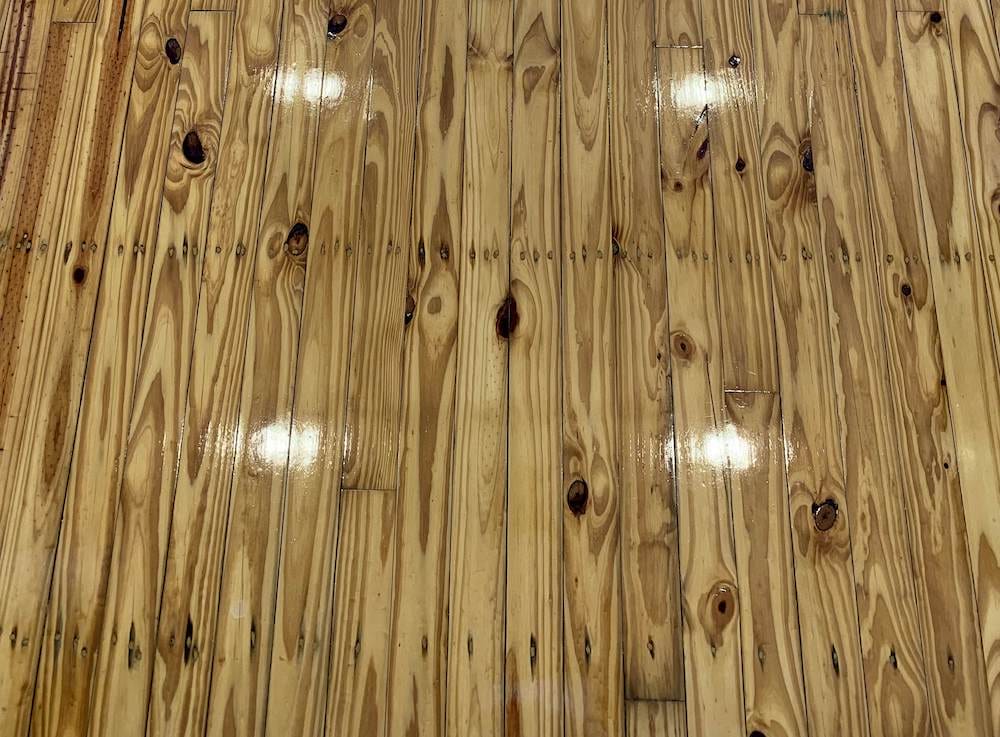Timber flooring adds a classy, old-school charm to any room in your home. Like a fine wine, it gets better with age and can last for decades with proper care.
When it comes to types of timber flooring, there are several options:
- Solid timber
- Engineered timber
- Parquet tiles
- Recycled timber
- Bamboo flooring
- Laminate flooring
- Hybrid flooring
Whichever type you choose, you’ll need to maintain it with regular cleaning and surface protection. For solid timber floors, you’ll need to refresh the seal or finish to make them water and scratch-resistant.
If you’re considering timber flooring for your home, here’s a rundown of the different types of timber and how to maintain them.
What is Timber Flooring?
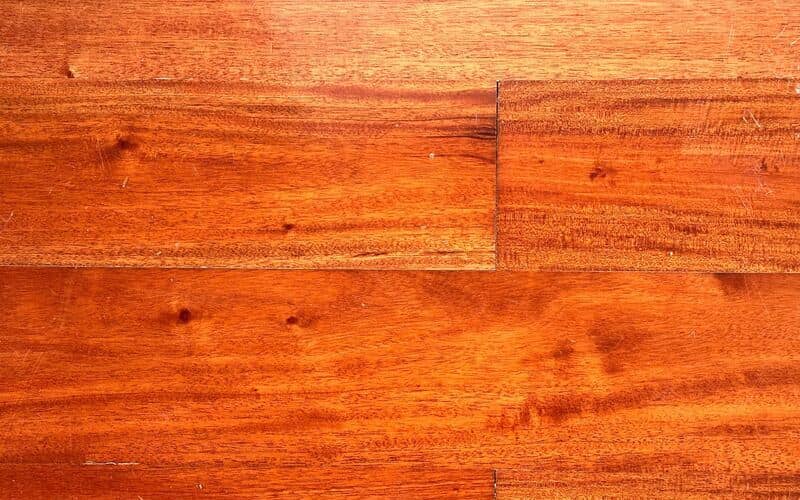
Timber floors (or hardwood floors) are made entirely from hardwood. In Australia, there are several types of hardwood species commonly used in floors.
Hardwood timber flooring is popular for many reasons – it lends a classic, old-timey aesthetic to any room. When installed and maintained properly, these floors can last decades.
Pros and Cons of Timber Flooring
The biggest “benefit” of timber floors is their aesthetic. Most people who go with timber flooring options want the natural beauty of real wood, from the grain to the colours.
Hardwood is available across a range of price points, from pricier solid timber to more affordable engineered timber.
Moreover, timber floorboards can be easier to repair, refurbish, or replace by sanding or other methods. Depending on the installation, you can simply remove the damaged floorboards and put in new ones.
And of course, ethically sourced wood is more environmentally friendly (especially for engineered flooring) versus other materials that are plastic-based.
There are downsides to timber flooring, though. Depending on the finish and installation, it’s less water-resistant than tiles or laminate.
Hardwood floors also need more maintenance since they scuff or scratch easily, especially in high-traffic areas. They may also need special cleaning products.
Different Types of Timber Flooring
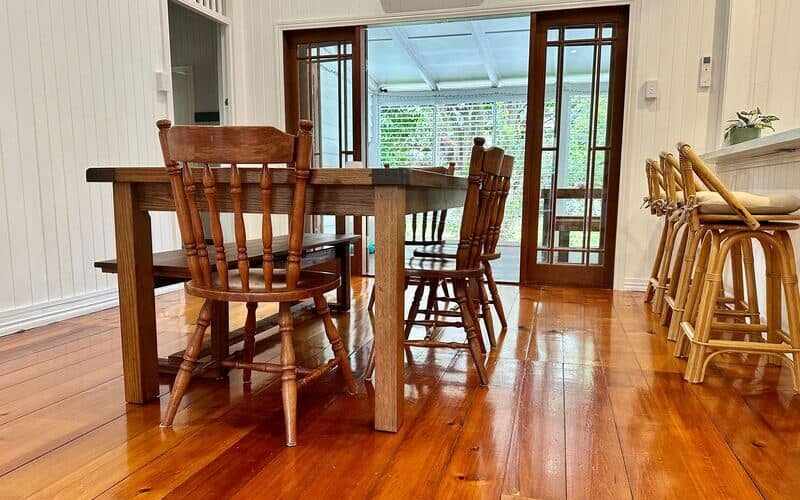
There are three main timber flooring types: solid, engineered, and bamboo.
Recycled timber is also becoming more popular as an eco-friendly option.
There’s no “best” type of wooden flooring – just the one that best suits your home and environment.
Solid timber flooring
Solid timber floors are exactly what their name says – they’re made from solid wood planks (or “real timber”). The wood is cut in a single plank and sanded to a smooth, even finish.
Part of the appeal is that each plank has natural differences in colour and grain, so the floor looks rustic and unique. Some boards come pre-finished, with a timber veneer to make it water and scratch-resistant.
Solid hardwood is exceptionally flexible and durable, and can be re-sanded or polished multiple times. However, it can be quite pricey and require specialised installation by professionals.
Solid timber is also not recommended for high-humidity areas.
Engineered timber flooring
Engineered timber floors consist of planks made from multiple layers of wood sheets. These thin layers are sealed together with adhesive to form one plank.
Compared to solid hardwood, engineered floors are more affordable and easy to install. They’re also lighter and more water-resistant, making them great choices for areas with high humidity.
Engineered timber is often used in floating floors due to its flexibility and weight. However, it may be less durable than solid timber.
Timber parquetry flooring
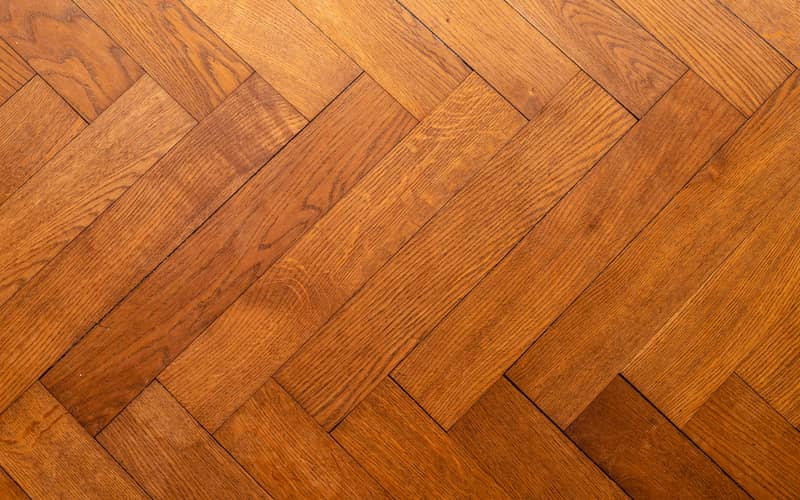
Parquet actually refers to the arrangement of wood planks, rather than the material. Parquet floors are made from narrow “tiles” of wood interlocked in a geometric pattern.
Common patterns for parquet timber flooring include herringbone, chevron, checkerboard, and mosaic. This allows floors to have a unique, interesting appearance.
Parquet tiles can be made of either solid or engineered timber. The tiles are pre-sealed and finished.
Modern parquet comes in pre-glued and finished tiles with a predetermined pattern, versus the older method of installing one tile at a time.
Recycled timber flooring
This timber flooring option has seen a rise in popularity as homeowners become more eco-conscious. Recycled timber floors use reclaimed wood – any wood that is salvaged from old structures and the like.
Companies will first inspect the wood for decay or infestations. They will then “strip” the wood and remove any nails, paint, and flaws. The wood is then dried and then milled into new planks.
Some benefits to using recycled hardwood, besides the ecological impact, are unique colours and grains, durability, and the chance to have old-growth timber that may no longer be on the market.
Non-Timber Alternatives for Flooring
If hardwood isn’t an option for you, there are non-timber alternatives that still give you the look or feel of wood!
Bamboo flooring
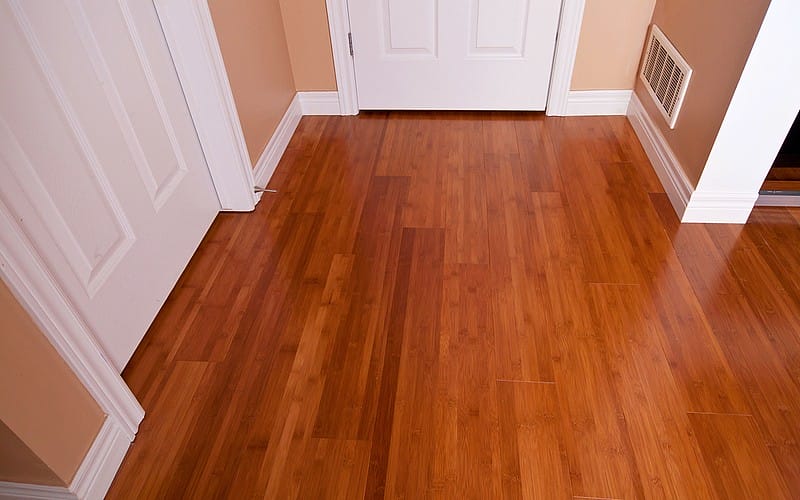
Bamboo flooring is a popular non-timber alternative if you still want that woody look. Bamboo is an eco-friendly substitute since it’s easy to propagate and farm.
To make bamboo floors, the plant is shredded into fibres, which are then reconstructed into planks through heat, pressure, and adhesive.
Laminate flooring
Laminate flooring is not real timber, but a synthetic material created to mimic the look of wood.
A laminate floor is usually made of a synthetic top layer with the appearance of wood, bonded to several layers of high-density fibreboard.
Laminate floors are affordable and easy to maintain. but often can’t replicate the look and feel of the natural product. They’re also susceptible to warping due to moisture.
Hybrid timber flooring
Hybrid floors are another modern alternative to solid timber floors. It combines laminate flooring with vinyl for easy installation and water resistance.
Hybrid flooring is typically made of a decorative layer on top of a composite board, finished with a protective coating. It’s affordable, low-maintenance, and more durable than laminate flooring.
However, the floor is easily scratched and may discolour due to light exposure.
Timber vs. Laminate Flooring
Timber floors (especially solid timber flooring) have a unique beauty and provide a warm, authentic aesthetic thanks to the colour and grain of the wood.
They can also be sanded and refinished multiple times over their lifetime, so they’re long-wearing.
Laminate flooring, on the other hand, is a more affordable option that’s easy to install, even by yourself. It offers the appearance of wood without the higher cost.
Still, laminate cannot replicate the rich colours or grain of real timber. It’s susceptible to moisture damage (like warping) and cannot be refinished – meaning if the laminate is damaged, you may need to replace the entire floor.
Common Types of Hardwood Timber in Australia
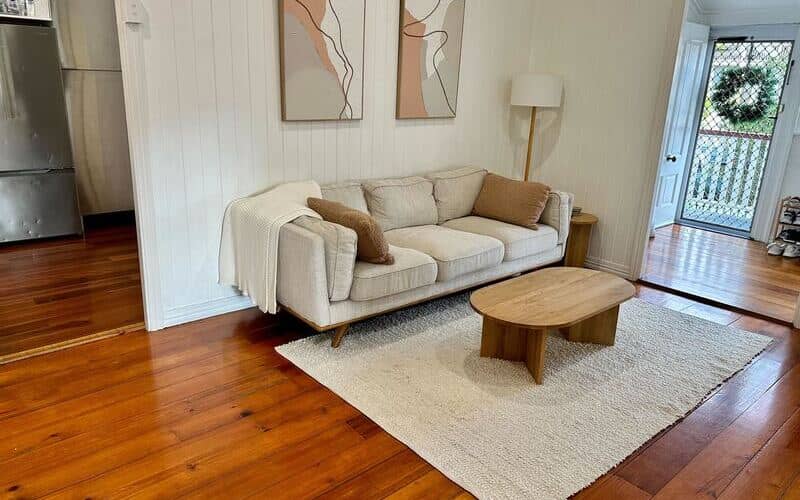
There are many types of Australian hardwood commonly used for floors. When choosing a type of timber, consider the colour, grain, Janka grade (hardness rating), and finish.
Common wood species used for timber flooring in Australia include:
- Australian beech: Also known as Tasmanian myrtle. Has high strength and versatility, with a wide range of warm tones.
- Blackbutt: A very significant Australian hardwood, as it’s important for the ecosystem. Has a straight grain, with colours from cream to pale brown.
- Brushbox: Also called the vinegar tree, Brisbane box, or Queensland box. Has a fine texture and a range of dark, rich colours in pinkish or reddish hues.
- Ironbark: Comes in grey or red species, with interlocking grains and a slightly coarse texture. Very resilient and hardy.
- Jarrah: Another popular Aussie timber species that houses wildlife and insects in the wild. As a flooring material, it comes in a rich red that softens over time and has high durability.
- Red mahogany: A eucalyptus variety found in eastern Australia. It’s a popular choice for solid timber floors thanks to its hardness and durability.
- Spotted gum: Gives floors a striking appearance thanks to its wavy grain. Considered a premium hardwood, especially as solid timber, thanks to its high Janka grade.
- Tasmanian oak: The iconic Tassie oak has a straight, even grain and a wide range of colours. Tasmanian oak flooring often combines alpine ash, mountain ash, and messmate and is commonly used for parquet tiles.
Types of Timber Floor Installations
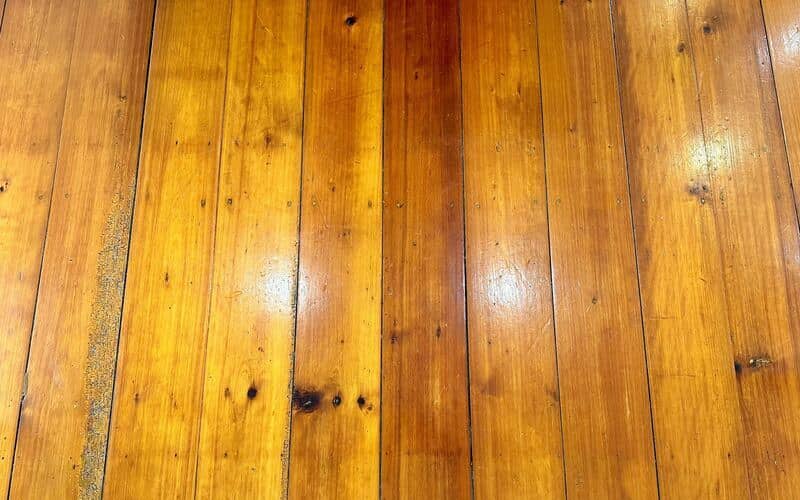
When choosing the type of timber for your floor, you’ll also need to consider the method of installation.
For timber flooring, you’ll typically have two options for installing the wood.
Direct-stuck timber floors
This involves directly attaching individual boards to the subfloor with an adhesive. It’s a popular method for installing solid timber planks since they can be quite heavy.
Direct-stuck floors have less movement, which makes them less susceptible to cracking or moisture damage. They’re also easier to clean and maintain.
However, they’re more expensive to install due to stringent requirements. It’s also difficult to repair existing floors, and you cannot cover the timber with additional flooring materials such as wall-to-wall carpet.
(Don’t worry, though – you can absolutely put rugs on direct-stuck floors.)
Floating floors
A floating floor is not bonded to the subfloor, but instead relies on its weight and friction to hold the timber floorboards in place.
That makes this method more affordable and DIY-friendly. It’s also easier to replace or remove floating floors since they’re not glued in place.
Engineered timber flooring is typically a floating installation, since the material is lightweight and easy to cut and attach.
However, due to the gap between the floating floor and the subfloor, the material is more susceptible to moisture and even mould. You’ll need to be more careful when cleaning floating floorboards.
Floating floors also grow or shrink with temperature changes, and creak or move. They also require a flat surface, or there could be gaps between floorboards.
Types of Timber Floor Finishes
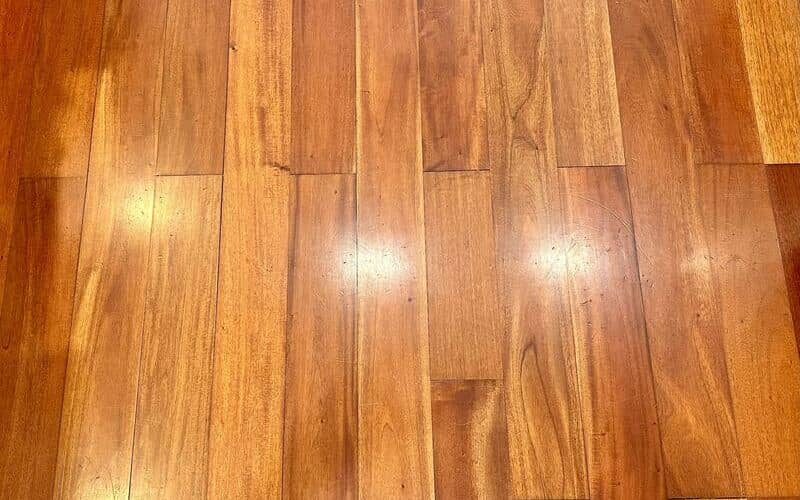
Solid timber flooring will often be finished with a polish after installation, to seal the wood and prevent scratching or moisture damage.
Engineered timber often comes pre-finished, as do parquet tiles and recycled wood planks.
Polyurethane
Polyurethane is a plastic polymer that provides an extremely durable finish. There are three types of polyurethane finishes:
- Water-based polyurethane (the most versatile and eco-friendly)
- Oil-based polyurethane (durable and can create an aesthetic “stain” with age)
- Moisture-cured polyurethane (highest water resistance)
It’s generally safe to use diluted vinegar to clean wood floors finished with a polyurethane coating.
Wax coating
Wax is a more “natural” finish for timber flooring, as it’s typically made from beeswax, linseed, paraffin, or other natural extracts.
It provides a sleek finish but offers minimal protection for scratches and scuffing. It’s also trickier to clean, as you need to avoid acidic products and any chemical cleaner not formulated for wax.
Shellac
Shellac is a natural laminate or polish made from resin flakes. As a finish, it’s warm-toned and quick-drying, so it’s easy to apply and maintain. It’s also great for blocking odours, so it’s the best wood finish for pet owners.
However, shellac is susceptible to water spots and cannot be cleaned with any oil or alcohol-based products.
Varnish
Floor varnishes typically mix different resins, such as acrylic, pine, or even shellac. Varnish offers a thicker coating and makes floors more resistant to water, abrasion, and even UV damage.
As a downside, varnish is easily dulled by water spots or scuffs.
How to identify your timber floor polish
If you’ve moved into a new home or apartment, you may not know the type of polish on the existing floor.
If your landlord or realtor can’t tell you, there are some simple tests!
- Water: Pour a tiny amount of water onto the floor. If the water absorbs quickly or leaves spots, your floor is unsealed and needs to be finished. Water beads indicate a sealed floor.
- Steel wool: Take some super-fine steel wool and lightly scrub a small corner. Waxed finishes leave a waxy residue while flaking indicates polyurethane.
- Denatured alcohol: Place a drop of the alcohol in an inconspicuous spot, then rub it with a paper towel. Shellac will create a residue.
- Lacquer thinner: If you try a drop of lacquer thinner and the surface becomes sticky, that’s a lacquered finish. Varnish, meanwhile, will remain undamaged.
Maintaining Timber Flooring in Your Home
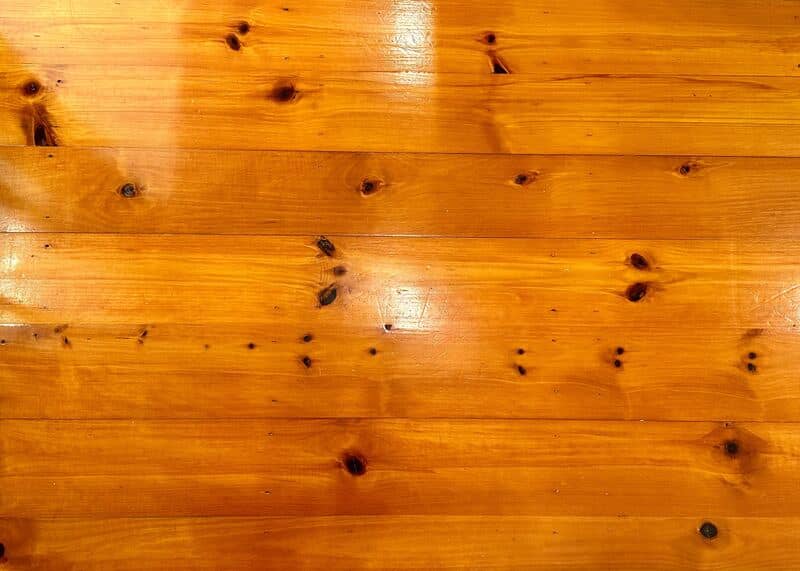
Regular cleaning and maintenance will go a long way towards maintaining the structural integrity and appearance of your timber flooring.
It’s important you use the appropriate products, otherwise you could damage the wood or finish. Avoid anything that contains bleach, ammonia, and similar harsh chemicals.
You should also avoid using a steam cleaner or mop as they could cause warping or moisture damage.
Cleaning timber floors
There are several ways to clean timber floors, but these four steps are a good baseline:
- Sweep using a soft-bristled broom or dust mop about once a week
- Wet mop using a mild detergent (like castile soap) and water or specialised floor cleaner
- Dry immediately with another mop to prevent prolonged water exposure
- Re-sand or refinish timber floors every 5-10 years
When wet mopping, make sure you wring out any excess water – you want to minimise the moisture used on the floorboards.
If you’re using commercial cleaners, go for ones made especially for wood surfaces. Some good quality choices include Black Diamond Wood and Laminate Floor Cleaner or Koala Eco Floor Cleaner.
You can use a vacuum only if it has a cleaner head or brush attachment suitable for hardwood. Try the Miele Boost CX1 Parquet Vacuum Cleaner or Bissell CrossWave Multi-Surface Floor Cleaner.
Of course, you can always hire a professional home cleaner to take care of your floors for you!
Removing stains from timber floors
Clean any spills, accidents, and other stains ASAP. The longer something sits, the harder it is to remove from your timber floors.
A soft cloth and some water (plus a mild detergent like castile soap) should take care of most messes.
For tougher stains, some solutions include:
- Super-fine (#0000) steel wool and wood floor wax
- Mild dish soap and water, followed by fine sandpaper
- A tablespoon of mineral spirits mixed in a bucket of warm water
- Wood-safe enzymatic cleaners
Always check a product to see if it’s safe for use on different types of timber flooring, and test it on a tiny spot. The last thing you want to do is ruin that classic, rustic look!
Fixing scratches on timber floors
Lots of things can scuff or scratch the surface of your timber flooring, whether that’s excited pets or general foot traffic.
Minor wear and tear can add character to the finish, but you can remove superficial scratches using:
- A wood stain marker
- Coloured wax stick
- Super-fine sandpaper or steel wool (#0000)
Try using rugs, mats, and protective furniture pads to minimise scuffing.
For potted plants, use saucers, water reservoirs, or padding underneath.

